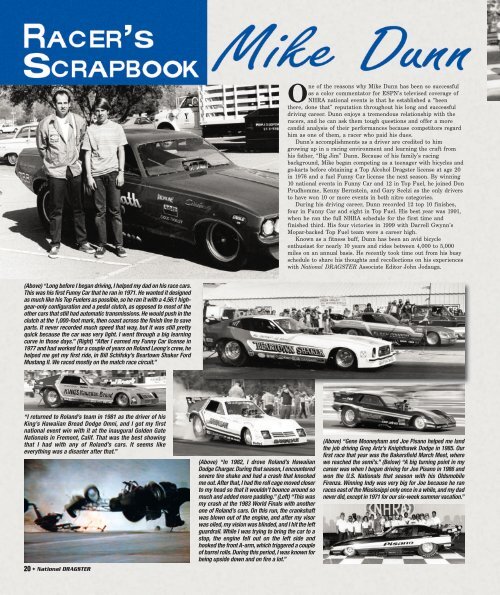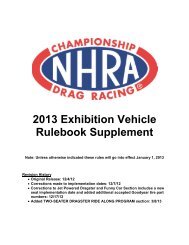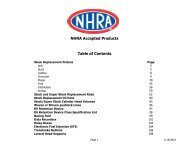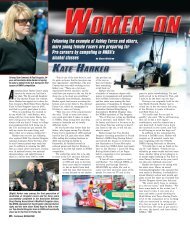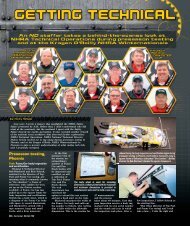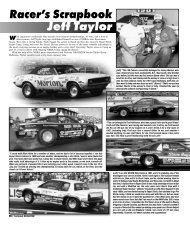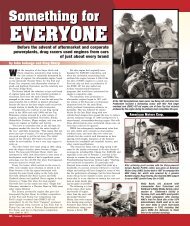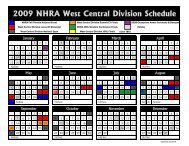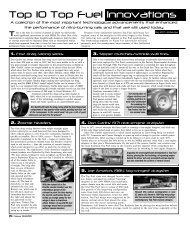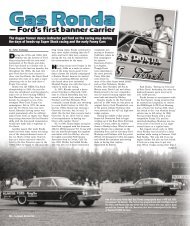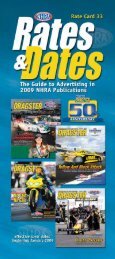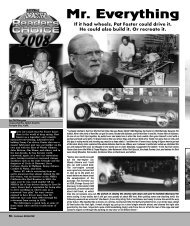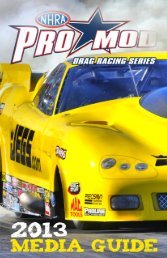020-021 Scrapbook Dunn - NHRA.com
020-021 Scrapbook Dunn - NHRA.com
020-021 Scrapbook Dunn - NHRA.com
Create successful ePaper yourself
Turn your PDF publications into a flip-book with our unique Google optimized e-Paper software.
One of the reasons why Mike <strong>Dunn</strong> has been so successful<br />
as a color <strong>com</strong>mentator for ESPN’s televised coverage of<br />
<strong>NHRA</strong> national events is that he established a “been<br />
there, done that” reputation throughout his long and successful<br />
driving career. <strong>Dunn</strong> enjoys a tremendous relationship with the<br />
racers, and he can ask them tough questions and offer a more<br />
candid analysis of their performances because <strong>com</strong>petitors regard<br />
him as one of them, a racer who paid his dues.<br />
<strong>Dunn</strong>’s ac<strong>com</strong>plishments as a driver are credited to him<br />
growing up in a racing environment and learning the craft from<br />
his father, “Big Jim” <strong>Dunn</strong>. Because of his family’s racing<br />
background, Mike began <strong>com</strong>peting as a teenager with bicycles and<br />
go-karts before obtaining a Top Alcohol Dragster license at age 20<br />
in 1976 and a fuel Funny Car license the next season. By winning<br />
10 national events in Funny Car and 12 in Top Fuel, he joined Don<br />
Prudhomme, Kenny Bernstein, and Gary Scelzi as the only drivers<br />
to have won 10 or more events in both nitro categories.<br />
During his driving career, <strong>Dunn</strong> recorded 12 top 10 finishes,<br />
four in Funny Car and eight in Top Fuel. His best year was 1991,<br />
when he ran the full <strong>NHRA</strong> schedule for the first time and<br />
finished third. His four victories in 1999 with Darrell Gwynn’s<br />
Mopar-backed Top Fuel team were a career high.<br />
Known as a fitness buff, <strong>Dunn</strong> has been an avid bicycle<br />
enthusiast for nearly 10 years and rides between 4,000 to 5,000<br />
miles on an annual basis. He recently took time out from his busy<br />
schedule to share his thoughts and recollections on his experiences<br />
with National DRAGSTER Associate Editor John Jodauga.<br />
(Above) “Long before I began driving, I helped my dad on his race cars.<br />
This was his first Funny Car that he ran in 1971. He wanted it designed<br />
as much like his Top Fuelers as possible, so he ran it with a 4.56:1 highgear-only<br />
configuration and a pedal clutch, as opposed to most of the<br />
other cars that still had automatic transmissions. He would push in the<br />
clutch at the 1,000-foot mark, then coast across the finish line to save<br />
parts. It never recorded much speed that way, but it was still pretty<br />
quick because the car was very light. I went through a big learning<br />
curve in those days.” (Right) “After I earned my Funny Car license in<br />
1977 and had worked for a couple of years on Roland Leong’s crew, he<br />
helped me get my first ride, in Bill Schifsky’s Beartown Shaker Ford<br />
Mustang II. We raced mostly on the match race circuit.”<br />
“I returned to Roland’s team in 1981 as the driver of his<br />
King’s Hawaiian Bread Dodge Omni, and I got my first<br />
national event win with it at the inaugural Golden Gate<br />
Nationals in Fremont, Calif. That was the best showing<br />
that I had with any of Roland’s cars. It seems like<br />
everything was a disaster after that.”<br />
20 ✦ National DRAGSTER<br />
(Above) “In 1982, I drove Roland’s Hawaiian<br />
Dodge Charger. During that season, I encountered<br />
severe tire shake and had a crash that knocked<br />
me out. After that, I had the roll cage moved closer<br />
to my head so that it wouldn’t bounce around so<br />
much and added more padding.” (Left) “This was<br />
my crash at the 1983 World Finals with another<br />
one of Roland’s cars. On this run, the crankshaft<br />
was blown out of the engine, and after my visor<br />
was oiled, my vision was blinded, and I hit the left<br />
guardrail. While I was trying to bring the car to a<br />
stop, the engine fell out on the left side and<br />
hooked the front A-arm, which triggered a couple<br />
of barrel rolls. During this period, I was known for<br />
being upside down and on fire a lot.”<br />
(Above) “Gene Mooneyham and Joe Pisano helped me land<br />
the job driving Greg Artz’s Knighthawk Dodge in 1985. Our<br />
first race that year was the Bakersfield March Meet, where<br />
we reached the semi’s.” (Below) “A big turning point in my<br />
career was when I began driving for Joe Pisano in 1986 and<br />
won the U.S. Nationals that season with his Oldsmobile<br />
Firenza. Winning Indy was very big for Joe because he ran<br />
races east of the Mississippi only once in a while, and my dad<br />
never did, except in 1971 for our six-week summer vacation.”
“Joe and I broke the speed record three times in 1987 with the<br />
Firenza. We were the first Funny Car team to break 270 mph<br />
with a 270.43-mph national record in Englishtown. We upped it<br />
to 274.64 in Indianapolis, then broke 280 mph with a 280.72-<br />
mph record in Dallas, where this picture was taken.”<br />
(Above left) “We switched to this black Oldsmobile Cutlass Supreme body with yellow trim in 1988, and to this day<br />
I think that this was the best-looking Funny Car I ever drove. It also ran real well, and I got my first back-to-back<br />
wins with it in Houston and Phoenix near the end of that year. I drove with Joe for four seasons, and I felt pretty good<br />
about that because a lot of other drivers didn’t last with him that long. Joe could be pretty intimidating, but I had<br />
known him while I was growing up, and we got along pretty well. We won five races together and finished in the<br />
top 10 three times without ever running the full schedule.” (Above right) “I signed on with Jack Clark for a threerace<br />
deal at the beginning of 1992 with the hopes that it would help him land a major sponsor. We ran the fastest<br />
speed at the time, 297 mph, in Houston. We thought we maybe had an outside chance of breaking 300 mph at the<br />
next race in Gainesville, but ignition problems slowed the car down, and Kenny Bernstein beat everyone else to it.”<br />
“I began the 1990 season without a ride, but later I got a<br />
call from Ed Abel, who owned a construction business in<br />
York, Pa. He managed to put together a deal with Snickers,<br />
and he had me move back to Pennsylvania [where <strong>Dunn</strong><br />
still resides today] to work out of his shop. We had to start<br />
from scratch and order a new Firebird Funny Car, towing<br />
rig, and tools. My dad was hired as the crew chief, and<br />
after our debut at Maple Grove Raceway, we were runnerup<br />
at the next race in Topeka, then won the following event<br />
in Dallas. We switched to a Dodge Daytona body in 1991<br />
and won three races for a third-place finish.”<br />
“This is Blaine Johnson, near lane, and I running<br />
the first side-by-side 300-mph clockings at Maple<br />
Grove in 1994. It was a close race, and we were<br />
fortunate enough to win with a 4.820, 304.66 to<br />
Blaine’s 4.841, 300.40. In 1995, we won three races<br />
and finished fourth in the standings.”<br />
“After my three-race deal with Jack Clark ended, I spent<br />
the rest of 1992 working on potential sponsors. Late in<br />
the year, I got a call from Darrell Gwynn, who still had<br />
several associate sponsors after he lost his major backing<br />
with Coors. I was able make a deal with La Victoria, and<br />
between the two of us, we were able to field a car at the<br />
start of 1993. We won in Denver and Dallas that year to<br />
finish fourth in the standings.”<br />
“The Yankee sponsorship came about when Hank<br />
Steinbrenner, the son of team owner George, gave Jerry<br />
Gwynn a call in the middle of 2000. Apparently, both Hank<br />
and George had followed drag racing very closely<br />
because they knew a lot about what Darrell and I had<br />
ac<strong>com</strong>plished during our careers. We unveiled the car<br />
with the Yankee paint scheme at the U.S. Nationals that<br />
year, then raced at the final three events before running<br />
the full schedule in 2001. When the Yankees announced<br />
the termination of the program near the end of the season,<br />
everyone on the crew decided to pursue other interests,<br />
and the team was dissolved. I had a few offers for other<br />
rides, but after auditioning for the ESPN gig, I decided to<br />
try it for a year, and the rest is history.”<br />
(Above) “There were some changes in 1996 after we<br />
acquired the Mopar sponsorship deal, and after Frank<br />
Bradley left the team following the Atlanta race, Ken Veney<br />
came on board as the new crew chief. Just four races after<br />
Ken joined the team, we won Memphis and finished as<br />
runner-up in Seattle.” (Below) “Our last year of the Mopar<br />
sponsorship was 1999, which was my best season with four<br />
wins. We were leading in the points when Mopar announced<br />
that they were ending their support earlier in the year, and I<br />
can’t remember that ever happening before. Still, we ended<br />
the year on a positive note by winning the World Finals.”<br />
“These are my current hot rods, a Giant NRS Composite<br />
mountain bike, on the left, and a Seven Odonata Ti road<br />
bike. I first started riding mountain bikes in 1996, and<br />
then I got together with Whit Bazemore when he was<br />
riding to recuperate from his accident. I switched to road<br />
bikes around 2000, and I would like to try downhill bike<br />
racing next, but it’s hard to do with the busy ESPN<br />
television schedule. I have kept my Top Fuel license<br />
current, and I still enjoy making runs on an occasional<br />
basis. I’m often asked if I’d ever return to driving again,<br />
but I’m pretty happy with the job I have.”<br />
October 17, 2008 ✦ 21


